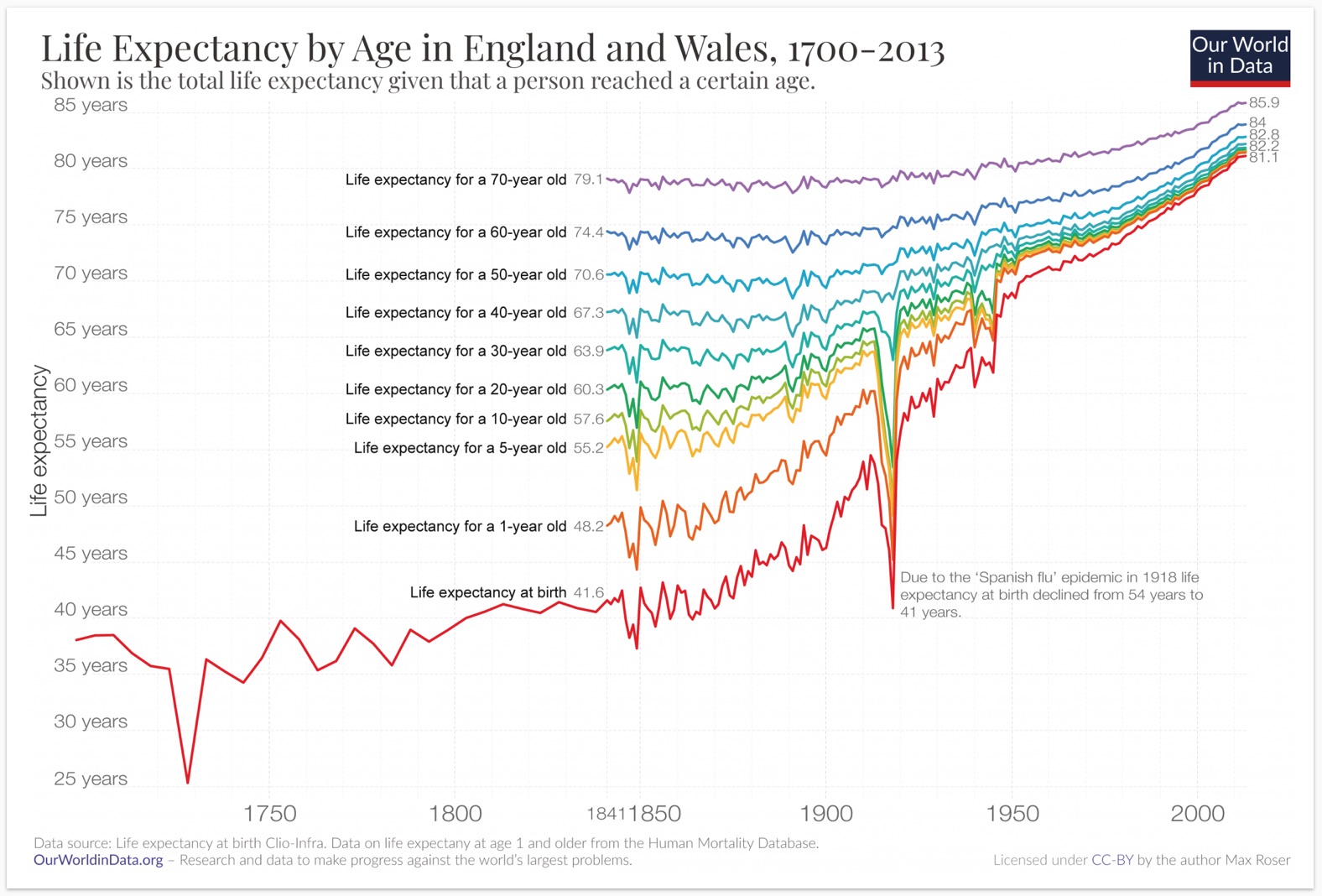home > questionable doctrine > last days
Did the Last Days start 1914?
Jehovah's Witnesses believe the "Last Days" commenced in 1914, a period of time leading up to Armageddon. Evidence are a supposed increase in pandemics, famine, war, earthquakes and crime since 1914. For more than 100 years since, every time there is a disaster, Jehovah's Witnesses are besides themselves that Armageddon is about to occur. This section shows these conditions have not become worse since 1914, and in most ways have greatly improved, and that Watchtower resorts to presenting inaccurate and misleading information to support its claims otherwise. Let’s examine if there has been an increase in these events since 1914.
Watchtower picks the specific categories war, pestilence, famine, food shortages and earthquakes as markers of the last days, based on the sign of Jesus presence in Matthew 24:7, and the imagery of the Four Horsemen in Revelation 6.
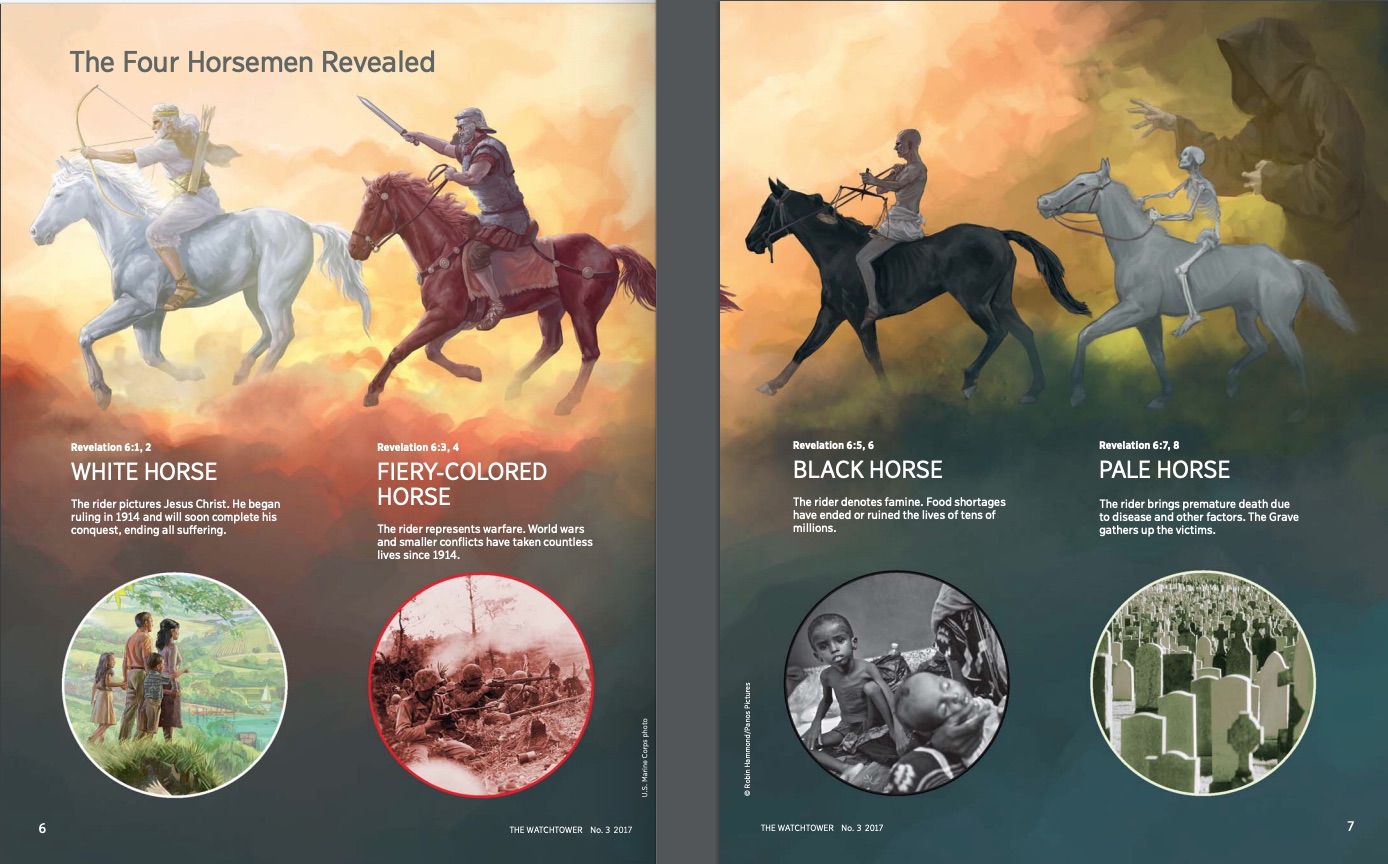
This article examines how the prevalence of these signs since 1914 compare to previous centuries, along with the accuracy of Watchtower comments regarding these topics.
- The Best Time in All History to be Alive!
- Pestilence - The Pale Horse
- Famine - The Black Horse
- War - The Fiery Coloured Horse
- Earthquakes
- Lawlessness
- Population Increase
- The Last Day of the Last Days
- When Did the Last Days Begin?
The Best Time in All History to be Alive!
Before starting, it is important to have a reality check about the period we live in. It is common to suffer from illness and financial stress and at times feel overwhelmed by life's anxieties. But these do not make this the worst time in history to be alive, or indicate these are the last days.
Imagine living in any other period in history. What century would you rather have been born in?
Prior to the development of modern medicine 200 years ago, childbirth carried a high risk of the child or mother dying? Diseases that are now curable led to death and pandemics continued for centuries? War carried on unabated, with civilians routinely raped and murdered? Photos from as little as a century ago show the majority of people living in squalor compared with today's standards.
Technological advances since the industrial revolution have resulted in dramatic improvement in the quality of life, readily identifiable by global life expectancy at birth rising from 28.5 years in 1800 to 68 years in 2007 (Riley, Rising Life Expectancy).
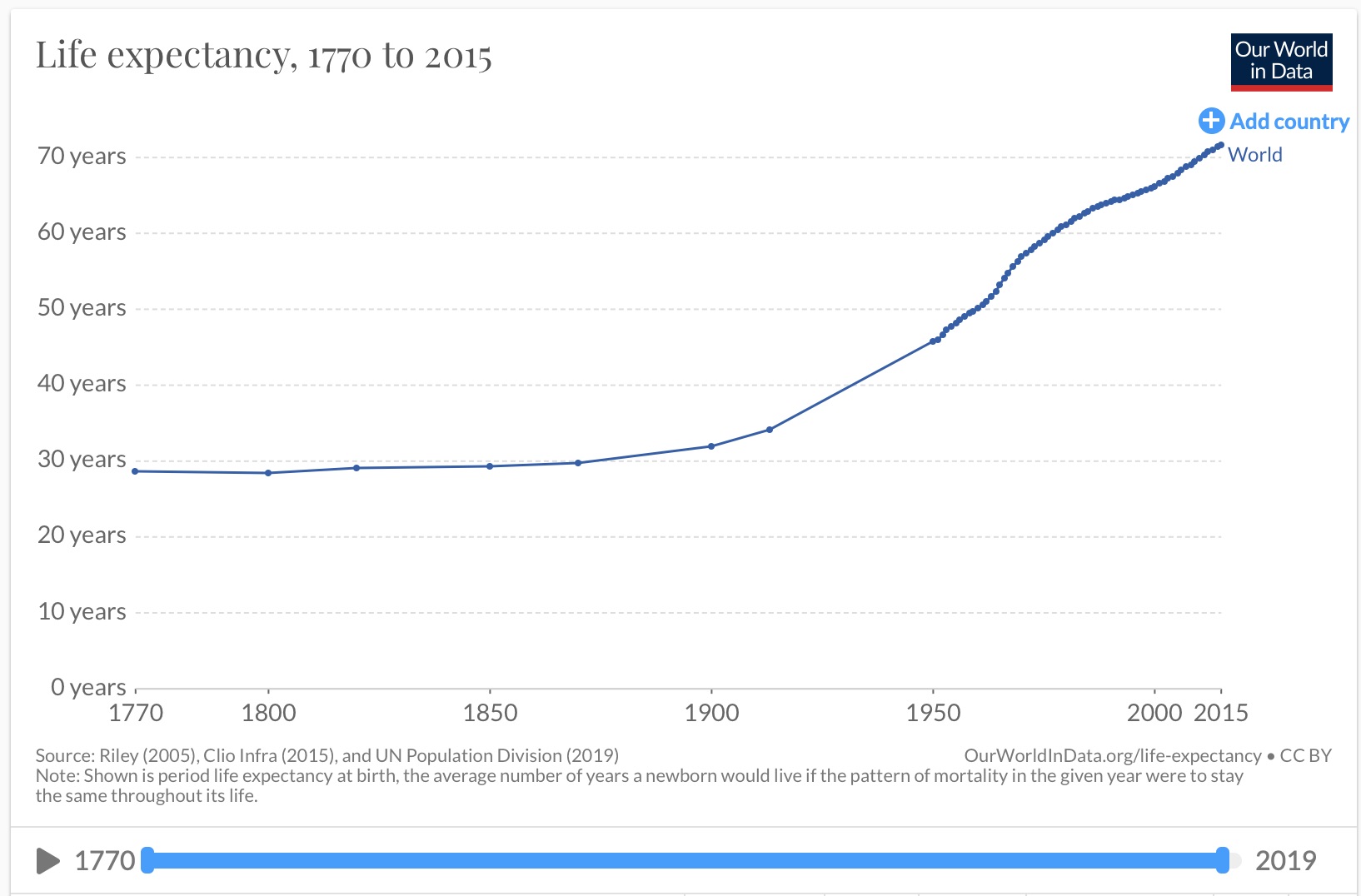
This is due to factors including a lower proportion of war related deaths, medical technology, better distribution of food during famine and greater preparedness for natural disasters such as earthquakes.
Living standards have improved across a vast range of measures. The following 55 second video shows the incredible improvement in the areas of child mortality, life expectancy, GDP, women's education, access to water and basic sanitation since the year 1900.
Watchtower's constant claims that humans are suffering through the most difficult living circumstances in all history since 1914 is based on either ignorance, or carefully crafted deception. Rather than appreciate how much safer and more enjoyable life is than in centuries past, it is sad Jehovah's Witnesses are required to wallow in the negative conviction that they are living in the most shocking of times, longingly waiting for this "worldly system" to end.
This article looks at the facts about pestilence, famine, war, earthquakes and lawlessness since 1914. It may come as a surprise that the suffering from every single one of these areas has seen significant declines over the last century.
Pestilence - The Pale Horse
Pestilence, another word for an epidemic, has scourged mankind throughout human history. For example, between 310 and 312 A.D. plague killed up to 99% of people in the Northwestern provinces of China. (End Time Visions: The Road to Armageddon p.274) Between 1346 and 1720 Europe suffered a plague on average every 6 years, often affecting over 30% of the population. During the 1800's, five Cholera pandemics killed over 40 million people, with some estimates ranging as high as 100 million deaths. [3]
The most fatal pandemic of all time was the black (bubonic) plague, which killed 75 million people in Europe between 1347-51 (abc.net.au 29 Jan 2008), and up to 200 million in the 14th century. (bbc.net.uk 3 Oct 2001). The Black Death was a "500-year-long pandemic." ("The cause of the Black Death finally identified by researchers" [Aug 17, 2022: Sandra Jacob, Max Planck Institute for Evolutionary Anthropology]
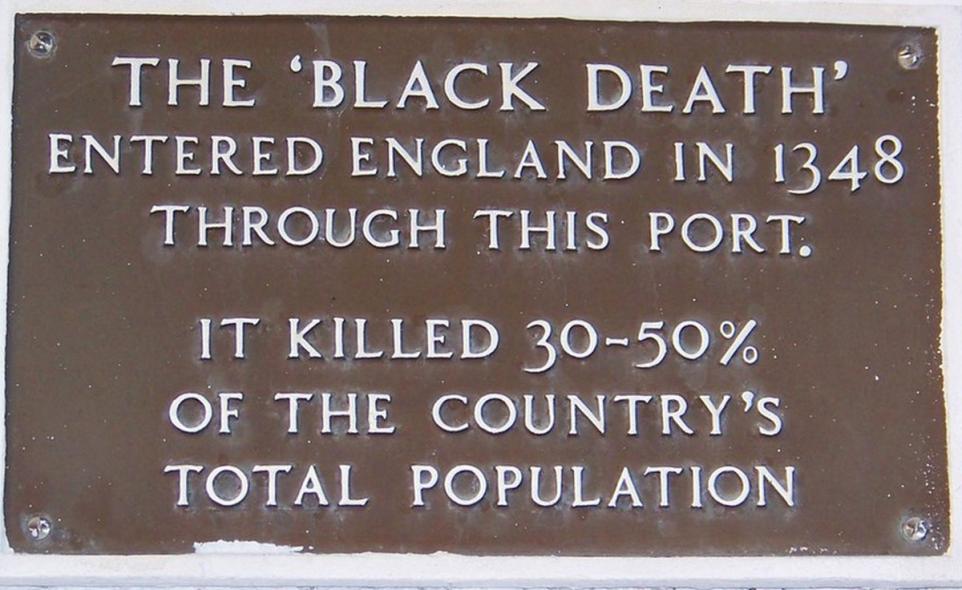
Image: Plaque Quayside Cafe Weymouth England
The "black horse" didn't start to ride in 1914. In fact, the affects of pestilence have reduced dramatically since the 20th century due to medical advances. Whilst globalisation can hasten the spread of an epidemic to other countries, and hence be called a pandemic, medical science has greatly minimised the rate of infections and death. An article entitled "Pestilence History of Public Health" in the Encyclopaedia Britannica 2002 states;
"In terms of disease, the Middle Ages can be regarded as beginning with the plague of 542 and ending with the Black Death (bubonic plague) of 1348. Diseases in epidemic proportions included leprosy, bubonic plague, smallpox, tuberculosis, scabies, erysipelas, anthrax, trachoma, sweating sickness, and dancing mania. … The development of microbiology and immunology had immense consequences for community health. … Evidence of the effectiveness of this new phase of public health may be seen in statistics of immunization against diphtheria-in New York City the mortality rate due to diphtheria fell from 785 per 100,000 in 1894 to 1.1 per 100,000 in 1940.
Something as simple as knowing to wash hands with soap only became a practice after the existence of germs became commonly accepted in the 1850's. Vaccinations became common in the mid 1900's, leading to dramatic decreases in deaths from polio, diphtheria, tetanus, anthrax, cholera, plague, typhoid and tuberculosis.
Watchtower attempts to prove pestilence has increased since 1914, but since this is not the case, it has been forced to resort to peddling misinformation. You Can Live Forever on Earth made the sensational claim that the Spanish flu was the deadliest ever.
"Right after World War I more people died of the Spanish flu than had died of any disease epidemic in the history of mankind. The death toll was some 21 million people!" p.151
This false statement is undermined by an earlier Watchtower article.
"The article notes that the sixth-century plague of Justinian "supposedly claimed 100 million lives-but it endured for 50 years." The 14th-century bubonic plague was said to have taken 62 million lives world wide, but it lasted for three years." Watchtower 1977 Jun 15 p.359
You Can Live Forever on Earth contained additional false reasoning in an attempt to make heart trouble and cancer a part of Jesus' sign.
"Yet pestilence and disease continue to rage. Millions die each year from heart trouble and cancer." You Can Live Forever on Earth p.151
At Luke 21:11 the physician Luke used the Greek word loimoi as part of the sign. Loimoi refers to an infectious malady or pestilence as separate from the words nosos (disease) or malakia (sickeness). Therefore Jesus was not referring to an increase in heart disease and cancer.
Medical advances against pestilence and disease have resulted in significant increases in life expectancy over the last 100 years. A working paper from the Australian National University, states:
"The average length of human life has roughly doubled over the last 200 years. Most of this increase took place over the last 100 years. In Australia, life expectancy at birth was 57 years in 1901-1910 and increased to 80 years in 2000. During the early part of the century, the greatest gains were due to reductions in mortality from infectious and parasitic diseases at young ages, while during the later part reduced mortality from chronic diseases at middle and older ages was the dominant factor." Beyond three score years and ten: Prospects for longevity in Australia Heather Booth & Leonie Tickle
Famine - The Black Horse
The Watchtower has regularly (and incorrectly) claimed that the greatest famines of all time have occurred post 1914.
"And in the wake of World War I came the greatest famine of all history." "Let Your Kingdom Come" p.122
"Shortly after World War I China had the biggest famine it ever had" From Paradise Lost to Paradise Regained p.181
These comments are entirely false. Apparently they refer to the following famines.
"In 1921, famine brought death to some 5 million people in the U.S.S.R. In 1929, famine caused an estimated 3 million deaths in China. In the 1930's, 5 million died of hunger in the U.S.S.R. Just a few years ago prolonged drought in countries bordering the Sahara Desert resulted in countless refugees and up to 100,000 deaths." Watchtower 1983 Apr 15 pp.5-6
Once again Watchtower resorts to distorting reality to support its 1914 theory. Famine related deaths since 1914 pale into insignificance compared to prior centuries. During the 2000 years prior to World War I, the world had a terrible history of famine, with many thousands of famines being referenced by researchers such as F. Curschmann, L. Delisle and A. Schultz. To indicate how numerous famine was prior to 1914, and how much greater their affect, consider the following:
- China 1876 9 million deaths
- India 1876-78 5 million deaths
- Persia 1871-73 1.5 million deaths
- India 1865-66 3 million deaths
- China 1849 14 million deaths
- Ireland 1846 1 million deaths
- India 1769-70 10+ million deaths
- France 1709 1 million deaths
During the 1800's alone, over 100 million Chinese died from famine. Reports abound of people from China, India, Ireland and England resorting to cannibalism (including of their own children) in an attempt to survive.
Famine has dramatically decreased since 1914, as can be seen comparing the above figures regarding the 1800s with the 1983 Watchtower figures for the 1900s. India and China have virtually eradicated famine over the last 50 years. During the early 1980's, charities managed to limit deaths in drought stricken Africa to 1 million. Since then, a combination of advanced crop technology and global charity efforts make famine related deaths in the millions unheard of.
The article Global Hunger: Calamitous famine eradicated in last 50 years by the Associated Press, 12 October 2015 shows how striking the reduction in famine has been.
"The study, part of the 2015 Global Hunger Index, says it's one of the "unheralded achievements" of the past 50 years: the elimination of calamitous famines that cause more than 1 million deaths, and reduction "almost to a vanishing point" of great famines, which cause more than 100,000 deaths.
"The trends are striking," said author Alex de Waal, executive director of the World Peace Foundation at Tufts University. Until the middle of the 20th century, millions died of famine every decade — from 27 million in 1900-1909 and more than 15 million in the 1920s, 1940s, 1950s and 1960s to a low of 1.4 million in the 1990s. So far this century, the death toll is near 600,000." cnsnews.com
The decade before 1914 resulted in 27 million deaths from famine, the decade before 2014 less than 0.5 million. Considering the increase in population from 1.75 Billion in 1910 to 6.9 billion in 2010, famine related deaths are a mere 1.9% of what it was prior to 1914, despite Watchtower rhetoric that we are deep into the last days.
War - The Fiery Coloured Horse
Possibly the most cited "proof" that Jesus started to rule in 1914 is that World War I started in that year. The Watchtower has attempted to present World War I as a unique turning point in history. Claims include:
"THE first world war was by far the widest and most destructive human conflict up to that time." Watchtower 1984 May 1 p.4
"No generation previous to that of 1914 ever experienced a world war, never mind two." Watchtower 1983 Jul 15 p.7
"Historians widely agree that World War I was the first war on a global scale." Awake! 1981 May 8 p.8
"World War I was an evidence of this, since it was so much worse than any war that had ever preceded it, which is why, at the time, it was called "The Great War." It was the first global or world war. It was total warfare and affected nearly every country on earth." Watchtower 1980 Oct 15 pp.14-15
Each of these comments is false. World War I was not the first "World" War, not the most destructive and not unique. Previous wars are also termed world wars, some involving more deaths and/or more countries. The following wars are all classified as world wars:
- The War of Spanish Succession 1702-1713
- The Seven Years' War 1756-1763
- The War of American Independence 1775-1783
- The Napoleonic Wars 1792-1815
Halvdan Koht in Folkets Tidsalder (Stolkhome 1982) p.7 states that the Napoleonic Wars were "a more than twenty-year-long world war, fought on all continents". On the other hand The Great War of 1914 (as it was originally referred to) was largely limited to Europe.
The Watchtower provides sensational, but contradictory numbers of deaths for World War I.
- 37 million Awake! 1961 Feb 22 p.6
- 14 million Awake! 1971 Oct 8 p.16
- 21 million Awake! 1983 Oct 8 p.12

The generally accepted combined figure of soldier and civilian deaths for World War I is 10-12 million. This figure pales next to The Taiping Rebellion of 1850-1864 that resulted in 40 million deaths, and is quite similar to the 10 million deaths of The Thirty Years' War of 1618-1648.
An even less truthful statement that the Watchtower has chosen to quote is at Watchtower 1975 Oct 15 p.633
"According to one study, World War I was reportedly seven times greater than all the 901 major wars of the previous 2,400 years"
This is a ludicrous statement, deaths from the 6 wars mentioned above alone come to many more times that inflicted by World War I.
The fact is that war has continued unabated throughout human history. The number of historical wars and war related deaths is hard to determine, not least as no one definition exists of what constitutes a war. Variables include whether or not to include civil war, how many deaths are required before being classified as a war, and whether to include the death of soldiers, civilians and deaths from resultant famine and disease. The massive extent of historical wars can be seen by a figure quoted by the Watchtower.
"As calculated by the Norwegian Academy of Sciences in 1969, the world has known only 292 years of peace since 3600 B.C.E., whereas 14,531 wars have been fought." Watchtower 1983 Apr 1 p.3
Though not mentioned by the 1983 Watchtower, the above report went on to say that these 14,531 wars have resulted in 3,640,000,000 (3.6 billion) people killed! Francis Beer examined and confirmed these estimates. In light of such figures the accuracy of the following comment can be understood.
"Unlikely as it sounds, there may have been no significant change over time in the incidence of peace and war and in the casualties of violence." Francis Beer, Peace Against War (San Francisco, 1981) pp.46,47
World War II is considered to be the most destructive war of all. Yet, since then the world has entered what is considered history's greatest period of peace from war ever. War researchers such as Q. Wright and also Singer and Small show a reduction in the frequency and length of war in the 20th century.
In A History of Violence by Steven Pinker it is shown that violence and warfare has been decreasing over the centuries. Particularly is this true since the 1950's.
"Violence has been in decline over long stretches of history, and today we are probably living in the most peaceful moment of our species' time on earth. According to anthropologists like Lawrence Keeley, Stephen LeBlanc, Phillip Walker, and Bruce Knauft, these factors combine to yield population-wide rates of death in tribal warfare that dwarf those of modern times. If the wars of the twentieth century had killed the same proportion of the population that die in the wars of a typical tribal society, there would have been two billion deaths, not 100 million. According to the Human Security Brief 2006, the number of battle deaths in interstate wars has declined from more than 65,000 per year in the 1950s to less than 2,000 per year in this decade."
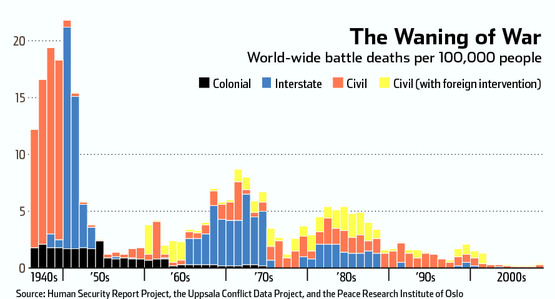
CREDIT: STEVEN PINKER/THE WALL STREET JOURNAL
Earthquakes
Watchtower publications, such as Survival into a New Earth (1984) p.23, make exaggerated claims of there being twenty times the number of earthquakes since 1914.
The frequency of earthquakes has not increased since 1914 and there has been no increase in the size of earthquakes. There has not even been more earthquake related deaths in the twentieth century, in comparison to some prior centuries. This information is readily available in encyclopaedias and from the United States Geological Survey website, which states:
"We continue to be asked by many people throughout the world if earthquakes are on the increase. Although it may seem that we are having more earthquakes, earthquakes of magnitude 7.0 or greater have remained fairly constant. … According to long-term records (since about 1900), we expect about 17 major earthquakes (7.0 - 7.9) and one great earthquake (8.0 or above) in any given year." earthquake.usgs.gov 27 Oct 2009
Watchtower claims to the contrary have been inaccurate and dishonest to such an extent that it warrants its own section and for detailed discussion please refer to Earthquakes since 1914.
Lawlessness
"Space does not allow us to give further details of contempt for God's laws, but what has been presented clearly shows that since 1914 there is an increasing of lawlessness on a magnitude unlike any period in history!" Watchtower 1983 Jun 1 p.7
Studies of lawlessness over long periods of time show that society is becoming gentler and less violent. Crime rates rise and fall over periods of decades but over centuries history shows that prior to the 20th was at least as lawless as today. However, an unfortunate tendency of humans can be to focus on negatives, as seen by the concentration on the nightly news of the bad occurrences of the day along with the saying 'the good old days'. People of all centuries have been quick to complain about the rise in crime.
"Most nineteenth-century Englishmen were convinced that crime was increasing as never before; eighteenth century commentators were thoroughly alarmed by what they saw as a rising tide of violent criminality; and complaints of the imminent breakdown of law and order punctuated the Middle Ages." J.S. Cockburn, Crime in England 1500-1800, Princeton, New Jersey, 1977 p.49
Watchtower claims that lawlessness is now at unprecedented levels is baseless. I am sure few people wish they lived in the Dark Ages rather than today. Nor would they wish to live in centuries where religion enforced temple prostitution and human sacrifices. Large advances have been made in increasing women's rights and reducing violence against women. An indication of the constant threat of violence people of prior ages faced is walled castles, as explained in the following book.
"A longer view, peering into the middle ages, or even the eighteenth century, might well give more substance to the theory. With all our crime, our society as a whole is more secure, less savage, than theirs. The mere fact that towns had to be walled, that castles ha to provide refuge for the surrounding villagers and their belongings, that travelers had to take their own protection with them, bears witness to the constant threat of brigands as well as the needs of warfare." Sir Leon Radzinowics and Joan King, The Growth of Crime (London, 1977) pp.10,11
Research (such as by Lodhi and Tilly) show countries such as France have had a dramatic decline in crime per population.
"In most modern western countries the level of crime has been so reduced that the misdeeds of the few serve rather to provide the ordinary citizen with escapist entertainment than to instill a sense of fear." John Bellamy, Crime and Public Order in England in the Later Middle Ages, London and Toronto, 1973, p.3
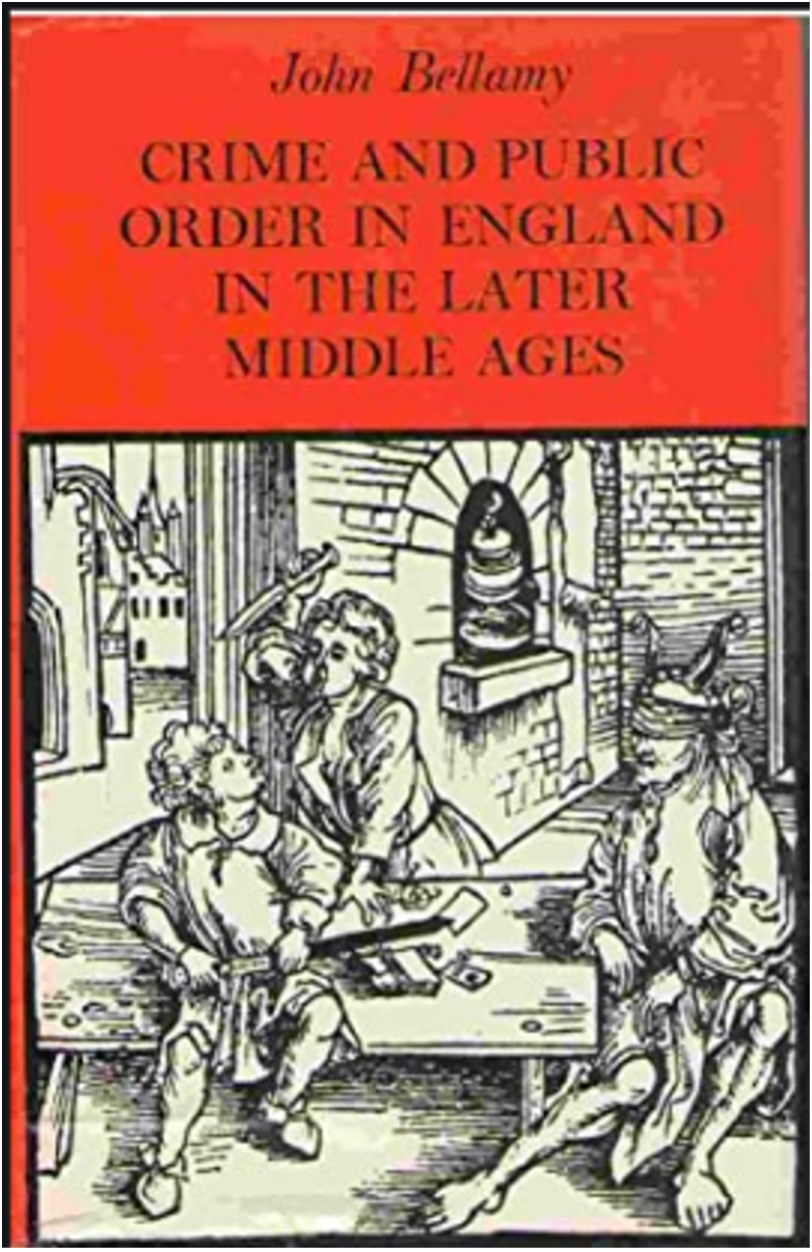
Christians were fed to lions for 300 years after the death of Jesus. A person can hardly compare the occasional soccer riots with the Roman gladiator games where people were forced to fight to their deaths.
Freakonomics explains that through the study of economics we are refining human behaviour, based on three incentives; economic, moral and social. It includes a table showing the fall in homicide rates over the last 900 years, to highlight how dramatic the improvements have been in the area of crime.
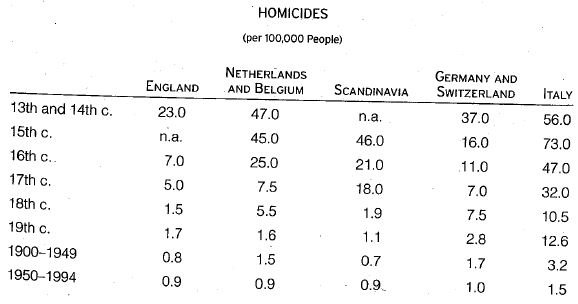
“Consider the historical trend in homicide (not including wars), which is both the most reliably measured crime and the best barometer of a society’s overall crime rate. These statistics, compiled by the criminologist Manuel Eisner, track the historical homicide levels in five European regions. The steep decline of these numbers over the centuries suggests that, for one of the gravest human concerns - getting murdered - the incentives that we collectively cook up are working better and better.“ Freakonomics pp.18,19 Revised edition 2006 SD Levitt & SJ Dubner
Pinker highlights how broad reaching the movement against violence has been in areas that we take for granted these days.
"... the 17th and 18th centuries ... saw the first organized movements to abolish socially sanctioned forms of violence like despotism, slavery, dueling, judicial torture, superstitious killing, sadistic punishment, and cruelty to animals, together with the first stirrings of systematic pacifism. Historians sometimes call this transition the Humanitarian Revolution." The Better Angels of Our Nature - Why Violence Has Declined Steven Pinker (2011 Viking Penguin) Preface
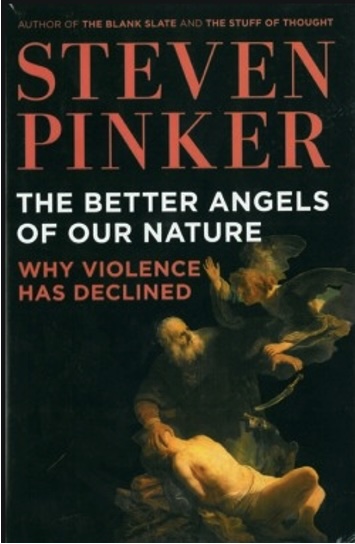
"Social histories of the West provide evidence of numerous barbaric practices that became obsolete in the last five centuries, such as slavery, amputation, blinding, branding, flaying, disembowelment, burning at the stake, breaking on the wheel, and so on. Meanwhile, for another kind of violence-homicide-the data are abundant and striking. The criminologist Manuel Eisner has assembled hundreds of homicide estimates from Western European localities that kept records at some point between 1200 and the mid-1990s. In every country he analyzed, murder rates declined steeply-for example, from 24 homicides per 100,000 Englishmen in the fourteenth century to 0.6 per 100,000 by the early 1960s." edge.org (Apr 3rd 2007) Quoting A History of Violence by Steven Pinker
Readers may find these figures hard to believe, and Pinker explains why.
"No matter how small the percentage of violent deaths may be, in absolute numbers there will always be enough of them to fill the evening news, so people’s impressions of violence will be disconnected from the actual proportions." The Better Angels of Our Nature - Why Violence Has Declined Steven Pinker (2011 Viking Penguin) Preface
Pew Research Center confirms this bias. Over 60% of Americans believe crime is increasing, despite crime falling considerably over the last few decades.
"Americans tend to believe crime is up, even when official data shows it is down.
In 23 of 27 Gallup surveys conducted since 1993, at least 60% of U.S. adults have said there is more crime nationally than there was the year before, despite the downward trend in crime rates during most of that period." What the data says about crime in the U.S.
The following graphs show that contrary to human perception, the dramatic fall in crime.

Population Increase
Population growth rates over time are a strong indication of the large death toll resulting from war, famine and pestilence prior to the 20th century. Population should increase exponentially, as has occurred during the 1900s. This was not the case prior to 1900.
The Awake! 1967 September 8 p.4 shows it took 1600 years from Jesus for the population to double from 250 million to 500 million.

Yet in the last 200 years it has doubled four times.
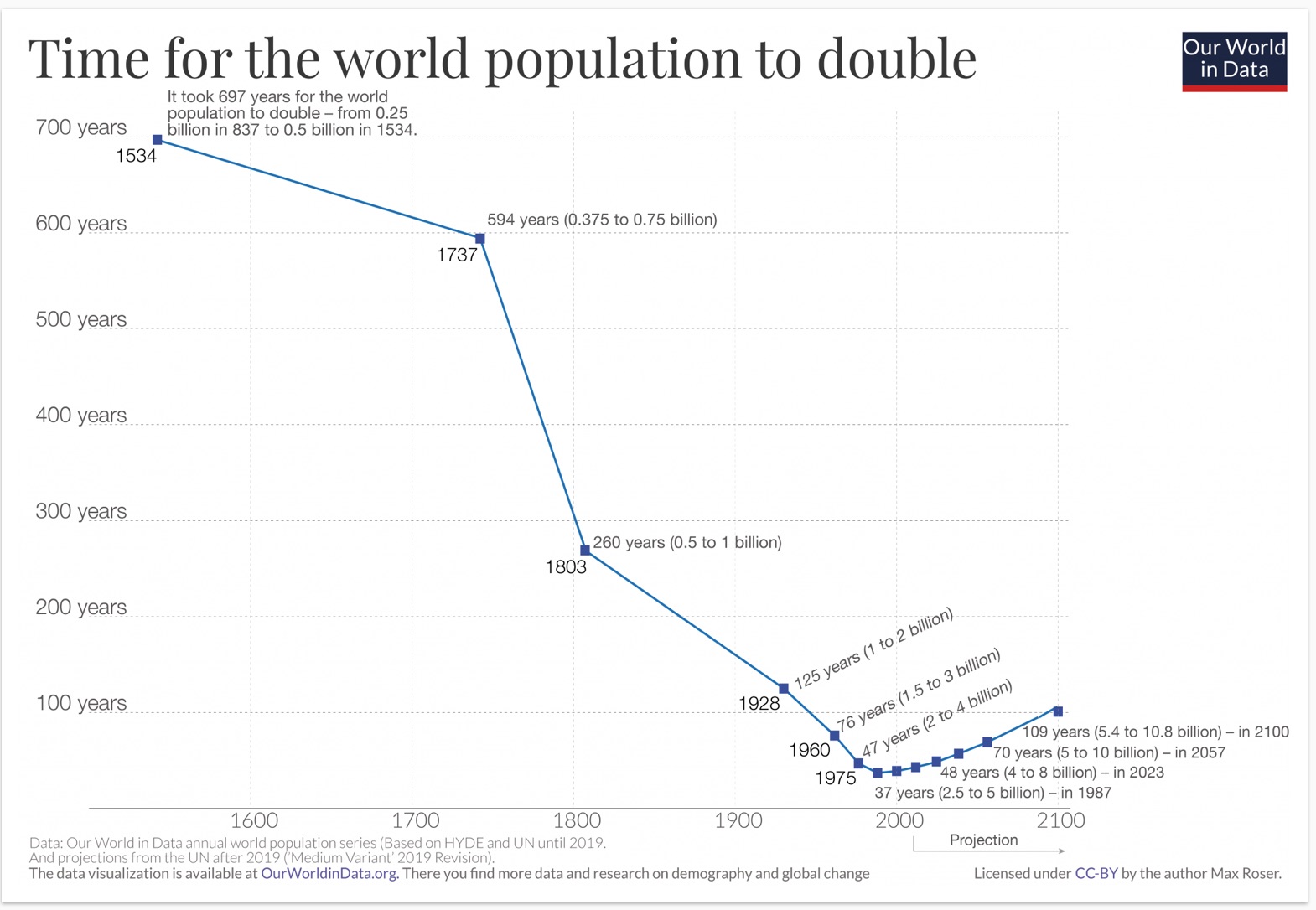
An increase in life expectancy plays the prominent part in this rapid population growth. Life expectancy increases are not just the result of improvements in mortality rates during child birth and infancy, as can be seen by an increase across all age brackets.
Knowing that in prior to the 20th century pestilence and famine regularly used to claim 30% and sometimes up to 90% of entire populations explains why it took 1600 years to double since Jesus. In the 1800's well over 250 million people died from famine, war, earthquake and pestilence, a huge percentage when the global population was barely 1 billion people, and most certainly not emulated since 1914. It is unfortunate that in a century of unprecedented peace and abundance Watchtower is intent on convincing its members that life is the worst it has ever been.
The Last Day of the Last Days

In 2019, Watchtower coined the phrase "the last days of the last days."
"... we are convinced that we are living during "the final part of the days." (Mic. 4:1) Because so much time has passed since 1914, we must now be living in the last of "the last days." Watchtower Study Ed 2019 Oct p.8
In the JW Broadcast March 2020, Lett used COVID-19 as evidence that:
"we're living in the final part of the Last Days. Undoubtedly, the final part of the final part of the Last Days, shortly before the last day of the Last Days."
This was followed by a flurry of messages from Jehovah's Witnesses to inactive family members to urgently return to the religion. The phrase "last days of the last days" has continued to be used since.
"... we are convinced that we are living during "the final part of the days." (Mic. 4:1) Because so much time has passed since 1914, we must now be living in the last of "the last days." Examining the Scriptures - 2021 April 22
"As we endure the last of "the last days," we expect troubles of increasing intensity." Life and Ministry Meeting Workbook May-June 2021
The Watchtower articles quoted above deceptively reference Micah 4:1 to support their phrase "the final part of the last days" even though Micah 4:1 does not indicate such a concept. The New World Translation uniquely translates Micah 4:1 as "the final part of the days," whereas most translations use "the last days." Watchtower articles are now adding the word "last" used in other translations to the word "final" used in the New World Translation, changing the Scripture from "the final part of the days" to "the final part of the last days," and then to "the last days of the last days."
When Did the Last Days Begin?
Peter showed that the Last Days commenced in the first century when he applied the prophecy of Joel to the outpouring of the Holy Spirit in 33 A.D.
Acts 2:17 "… this is what was said through the prophet Joel, "And in the last days," God says, "I shall pour out some of my spirit upon every sort of flesh …"
Jesus's signs of the last days ended with the fall of Jerusalem's temple in 70 A.D. Matthew 24 makes this point throughout; with references to the temple in verses 1-3, the holy place in verse 15, Judea in verse 16 and the Sabbath in verse 20.
For Watchtower to arrive at the idea that the Last Days commenced in 1914, it ties together five disparate concepts. This concoction presents that;
- The last days mentioned by Paul, James and Peter,
- had a minor and major fulfilment,
- with the major fulfilment commencing at the end of the Gentile times[4] alluded to in Luke,
- predicted to be in 1914 by Daniel's Seven Times prophecy,
- which are now confirmed by Jesus' signs of Matthew 24 and Luke 21.
There is no good reason to combine these concepts together as one.
Since Peter shows the Last Days commenced in 33 A.D., and Jesus' signs ended with the fall of Jerusalem's temple in 70 A.D., Watchtower is forced to claim the last days has two fulfillments, a minor and a major one. This is based on wishful thinking rather than sound Scriptural reasoning. Jesus himself said that the great tribulation that occurred in 70 A.D. would only occur once.
Matthew 24:21 "for then there will be great tribulation such as has not occurred since the world’s beginning until now, no, nor will occur again."
Luke 21:28 proves the last days didn't start in 1914 by saying:
"But as these things start to occur, raise yourselves erect and lift YOUR heads up, because YOUR deliverance is getting near."
The deliverance of those that saw "these things start to occur" in 1914 never occurred. As of 2023, only a few hundred people alive in 1914 are still alive. This also applies to the illogical "overlapping generation" doctrine.
Jesus warned against following those who made claims the end had approached.
Luke 21:8 "Look out that YOU are not misled; for many will come on the basis of my name, saying, 'I am he,' and, 'The due time has approached.' Do not go after them."
Conclusion
Apocalyptic religions such as Jehovah's Witnesses insist the Last Days are a short period of time that they presently live in.
"Yes, the world really changed in 1914!" Awake! 1981 May 8 p.8
Awake! 1968 Oct 8 p.5
The signs of the Last Days are so generic that it is easy to apply them to any period in time. Every century since Jesus has had its share of Christian sects claiming their century as the worst time in history. 300 years ago Newton wrote:
"This I mention not to assert when the time of the end shall be, but to put a stop to the rash conjectures of fanciful men who are frequently predicting the time of the end, and by doing so bring the sacred prophesies into discredit as often as their predictions fail." [1a]
The first page of the first Watchtower claimed it a fact that the 1800's were the Last Days.
"That we are living “in the last days” - “the day of the Lord” - “the end” of the Gospel age, and consequently, in the dawn of the “new” age, are facts not only discernible by the close student of the Word, led by the spirit, but the outward signs recognizable by the world bear the same testimony, and we are desirous that the “household of faith” be fully awake to the fact, ... " Zion's Watch Tower 1879 Jul 1 p.1
Watchtower's founder, Charles Taze Russell, taught that the "time of the end" started in 1799, borrowing his complex eschatology from the nineteenth century Adventist movement. He claimed his lifetime, the 1800's, had the worst conditions in history, proving the Last Days would end in 1914.
"... our readers are writing to know if there may not be a mistake in the 1914 date. They do not see how present conditions can hold out so long under the strain." Watchtower 1894 Jul 15 p.224
The failure of each of Russell's Adventist predictions necessitated adjustments by Watchtower's second leader, Rutherford, who moved the start of the Last Days into his own lifetime. Rutherford changed a nineteenth century explanation into a twentieth century one, and from the 1930's he said the Last Days started in 1914. (See Changed Dates.)
Currently the Watchtower points to the 20th and now 21st centuries as unique fulfilment of war, earthquake, pestilence and food shortage.

Does God Really Care About Us? Part 9
In order to support it's theory that Jesus unseen heavenly rulership commenced 1914, Watchtower calls 1914:
"… the "turning point" of modern history the pivotal one for mankind, because that is when the world entered a period of difficulty never before experienced on such an earth-wide scale." Watchtower 1980 Oct 15 pp.14-15
This is a serious misrepresentation of facts as historical evidence proves there has never been a safer, more desirable period of time to live. [2]
There have always been doomsday sects. Click here for a list of failed pre-1914 predictions.
Each century has suffered war, plague, food shortage and earthquakes, often on a scale greater than modern times. For instance, in the fourteenth century the "great famine" of Europe in 1315-1317 caused conditions so bad that parents are recorded as eating their own children and a marked increase in crime. In Medieval Europe: Crisis and Renewal T.F. Ruiz shows rape and murder were far more common in the fourteenth century than the twentieth. Warfare spanned the century, with the Mongol Empire killing an estimated 40 million people in its conquest of Eurasia. Percentage wise, this was twice that of the Second World War. 1337 saw the commencement of the longest war in history - the hundred year war between France and England. Like every century, ongoing earthquakes caused constant havoc, death and destruction. The weakened population then succumb to the Black death, a bubonic plague starting in 1347 that killed one third of Europe and caused in total over 70 million deaths. The result was that within a century the global population is estimated to have reduced from 450 million to only 350 million.
In the sixteenth century, comments from religious writers echo those made by Watchtower today.
"6,000 years have elapsed since Creation, and the World should last no longer than that. God should then punish mankind with plague, starvation and death in the final days - and has He not done that?" Bishop Peter Palladius, 1555
"The World is so evil that it cannot grow any worse. A child 7 years old knows more about wickedness than old people did before. Fidelity and love exist no more. The signs in the Heavens cannot be misunderstood. There is blood, pain, suffering, devils and demons everywhere." Bishop Olaus Petri, c.1550
"The End is near." Historian and theologist John Carion, 1532
"A huge battle has taken place in the Heavens. Antichrist will be thrown out in 1672. There will then come a short period when the Word of Christ will be preached worldwide in all its purity and cleanness and clearity, before Christ will come for the second time." Theologian Andrew Osiander c.1550
In 1828, John Stuart Mill stated, "I have observed that not the man who hopes when others despair, but the man who despairs when others hope, is admired by a large class of persons as a sage." The natural pessimism of human nature is part of our survival nature, but has been taken advantage of by religious leaders, such as Watchtower founder Charles Taze Russell.
A quick glance at the jw.org Newsroom shows this pessimistic attitude remains the key focus of the religion. A snapshot from October 2018 showed all the current press releases related to either natural disasters, or the concept that Jehovah's Witnesses are being persecuted.

Screenshot jw.org/en/new/jw 8th October 2018
Watchtower rhetoric on both these subjects is false. Not only are earthquakes no more frequent than in previous centuries, these press releases include typhoons and tsunamis; neither of which are part of the Jesus' sign. They are simply pessimistic stories to make followers wallow in how pitiful life is.
The idea that Jehovah's Witnesses are being persecuted, supported by members being jailed for refusing military service, is equally hollow. The number of Jehovah's Witnesses suffering for their beliefs is inconsequential in comparison to the death and suffering that is happening to other religious groups. In no way does it compare to what early Christians experienced at the hands of the Roman Empire.
The tragedy of the doomsday mindset and Watchtower deception regarding world conditions is it perpetuates negativity towards current life, and a lack of appreciation for the great advances of the last century. Furthermore, it dissuades from attempts at further improvement. Such a pointless mindset is a blight on human nature, and many thousands of years ago Solomon categorises those that believe such as unwise:
Ecclesiastes 7:10 "Do not say: “Why has it happened that the former days proved to be better than these?” for it is not due to wisdom that you have asked about this."
Worship should not be based on serving to a date or earning salvation at Armageddon; it should revolve around serving God. It is not necessary to know when Jesus Second Coming will be. Christianity manifests itself by showing love for God and love for neighbour regardless of the future.
Further Reading
See also Does The Current Recession/War/Pandemic Prove Armageddon is Close?
Footnotes
[1a] Isaac Newton's Prophecies Revealed to Public for First Time in Jerusalem-Makes Prediction About Second Coming of Christ by AP/TN : Jun 20, 2007 : AP christianpost.com
[2] Much of the following information has been referenced from The Signs of the Last Days - When?, Carl Olof Jonsson, Wolfgang Herbst (Commentary Press 1987). This book contains a detailed analysis on the signs, supported by numerous secular quotes.
[3] The Signs of the Last Days - When?, Carl Olof Jonsson, Wolfgang Herbst (Commentary Press 1987) p.106, Bergmark, pp. 191,207-209, Herbert L. Schrader. Und dewh siegte dm Leben (Swttgart. 1954), pp. 64-67,70. 71.
[4] The term "Gentile Times" never appears in the New World Translation of the Holy Scriptures, yet is used over 500 times in the Watchtower during the 50 years between 1950 and 2002. It originates with Luke 21:24 - "Jerusalem will be trampled on by the nations, until the appointed times of the nations are fulfilled."
Ukrainian translation of this article.
Written 2006. Latest update April 2024.
![]() Paul Grundy 2005 - 2024
Paul Grundy 2005 - 2024

